JEAN DEGOTTEX & JEAN-BAPTISTE BERNADET, TRAVESS SMALLEY, KEITH J. VARADI
SEPTEMBER 7 - OCTOBER 26, 2013Press release
Jean Degottex – resources: Centre Pompidou (EN) – Wikipedia Bio (FR)
Jean-Baptiste Bernadet – www.jbbernadet.com
Travess Smalley – www.travesssmalley.com
Keith J. Varadi – www.keithjvaradi.com
Opening: Friday, 6 September from 2pm to 8 pm
EN
Rien avant, rien après, tout en faisant. Jean DegottexSébastien Ricou is proud to present a group exhibition including recent work by Jean-Baptiste
Bernadet, Travess
Smalley and Keith J. Varadi around a major painting by Jean Degottex, Lignes-Report V from 1977.
Jean Degottex (1918-1988) is a French painter, a major artist but still underestimated; twenty-five years
after
his death, he still hasn’t been the subject of a retrospective exhibition in a French museum. Initiated by
André
Breton to Zen philosophy, Chinese calligraphy and the Surrealist automatic writing, Degottex spent his life
creating series of paintings on canvas or paper aiming to erase the creative subject. Combined with his
interest
in American abstract painting this research lead him in the 70s to make a series of particularly ambitious
paintings, not only by their unusual format in France at the time (two by three meters, two by six meters),
but
also by the almost total withdrawal of the gesture of the artist, an indirect inscription of the pictorial
surface, a minimalistic and radical process that influenced, among others, Martin Barré.
In this series named Lignes-Report, the raw linen canvas is coated with black acrylic paint, folded in half,
then a screwdriver is used to draw parallel lines while the material is still wet. Unfolded, the fabric have a
recessed portion, the recessed lines of the screwdriver, and a raised portion. The paint lets the canvas
appear
in the places where the lines were drawn on the reverse. Background, shape, sign, writing, everything is
played
out in the process, which is an accident machine. As written by Maurice Benhamou in 1993, “It is thus the
infinity of possibilities that the accident highlights. But at the same time it makes apparent the
impossibility
that constitutes the painting”.
This makes Degottex a pioneer of what Raphael Rubinstein proposed to name “provisional” painting in an article
published in 2009 in Art in America: “Provisional paintings are those that might appear unfinished or
incomplete; that court intentional awkwardness, physical fragility and instability; that reject the display of
conventional skills; that discover beauty in the most unassuming materials; that sometimes grapple with
painting’s ‘impossibility’. Their lineage includes Joan Miró’s anti-paintings of circa 1930, Giacometti’s
endless obliterations and restartings of his painted portraits, the early work of Sigmar Polke, and the
spray-painted abstractions of Martin Barré. The theoretical underpinnings range from Samuel Beckett to Gilles
Deleuze and Félix Guattari’s Kafka: Toward a Minor Literature.”
This inclination towards the process, the rules of the game as a means to continue painting is one of the
major
trends of contemporary painting; which can not or does not want to rest on the idea of progress or invention
and
that therefore seeks to avoid any form of grand narrative or heroism. Many artists of today share with the
audience their own surprise about the endless possibilities of this medium. This humble approach, at a
minimum,
comes to us particularly from a new generation of American critics and painters. The rediscovery of artists
such
as Martin Barré, Simon Hantaï and Hans Hartung in Europe is partly due to the curiosity of American artists
who
had drawn into these works, neglected in their own countries of origin.
The large dimensions of the paintings in the series Lignes-Report, far from staging a kind of “physical” (or
“virile” to use one of the adjectives often associated with American Abstract Expressionism) creative power,
instead served Degottex to completely wipe himself out of the painting in order to better propose a space as
vast as possible, which is deprived of any formal element. Degottex explains that the grounds of the painting
are thus “neither real nor figurative.” They are a space without reference, articulated with the space
surrounding the painting.
When artist Jean-Baptiste Bernadet began to think of an exhibition of painters of his generation gathered
around
the work of Jean Degottex, whom he knows and appreciates since his formation at the Beaux-Arts, the unique
format of the paintings in this series seemed a good starting point. Rather than proposing to the artists to
reflect on the process or tools in the paintings of Degottex, he preferred to offer them to work on a common
format, the same as the one from the series Lignes-Report lent for the exhibition, one could say to work on a
common space.
The exhibition at Ricou Gallery thus presents four paintings of the same size, all identical to the dimensions
of the painting by Degottex (290 x 205 cm). It is a painting exhibition, but also a coexistence of four spaces
in which the viewers can immerse themselves just as in an architectural structure.
***
Jean-Baptiste Bernadet (b. 1978 in Paris, lives and works in
Brussels) appropriates the codes that make up the
history of art and painting, both in his relation to the image and to the act of painting. Each painting
appears
as an attempt to appropriate painting, to make it one’s own. Appropriation here is not about the simple
reproduction of an act, an image or a code, but instead about a subjection that entails their
displacement.
For the exhibition, Bernadet produced the painting Untitled (Screensavour) with a single gesture. The colors,
straight out of the tube, are arranged on the blank canvas. Using thinner, the colors are then spread, like
melted together. The picture is therefore shaped by the gestures of brushing, spreading, filling the surface,
virtually erasing rather than adding or composing, a priori. This is how the colors are connected to each
other,
like a layout of sensations, which determines the composition. This is a brightly colored painting, an
unstable
landscape, a projection screen for multiple and changing interpretations.
Travess Smalley (b. 1986, West Virginia, USA, lives and works
in New York) is a painter and printmaker whose
practice involves blurring the lines between the digital and the physical through prints, sculptures, and
books.
His process questions the changing definition of painting, and utilizes every day home office tools such as
the
scanner, inkjet printer, and creative computer software to explore modernist ideas of composition, color, and
form.
Referring to the horizontal lines structuring the painting of Degottex, Smalley shows a printed tarp. The
painting is produced on a computer from a hardcopy, then rescanned and further modified. This amplifies and
maximizes the kinetic effect and the vibration of the grid while maintaining a visible trace of the
materiality
of the paper.
Keith J. Varadi (b. 1985, Pittsburgh, USA, lives and works in
New York) is interested in the effects of color
saturation in the physical vs. color saturation in the virtual, the legibility of image vs. non-image,
painting
as labor, and paintings as self-marketing products. His paintings are mimetic in their allusions to the
general
hermetic nature of painting, as well as the often shallow language of abstraction, imitating both the act and
the affect. Having said that, these paintings are not meant to be read as cynical, but rather as honest
attempts
at articulating the frustrating task of determining what is art, what is not, what is work, what is not, what
is
pleasurable, what is not, and so on.
The painting presented in the exhibition, Reverse Quadchrome (RGB) is the result of an almost blind protocol:
after painting the canvas on the floor with three successive layers of paint, red, green, blue, the three
colors
were mixed then applied in a final layer of black color, producing a subtractive addition. The canvas is then
stretched “reverse side up” on the frame, showing the four layers of paint penetrating the cloth, revealing
the
time of completion in the form of its thickness and flattening.
FR
Rien avant, rien après, tout en faisant.
Jean Degottex
Jean Degottex (1918-1988) est un peintre français, artiste majeur mais encore largement sous-estimé (il n’a
toujours pas fait, vingt-cinq ans après sa disparition, l’objet d’une rétrospective dans un grand musée
français). Initié par André Breton à la philosophie Zen, à la calligraphie chinoise et à l’écriture
automatique
surréaliste, Degottex aura passé sa vie à créer des séries de peintures sur toile ou papier visant à
l’effacement du sujet créateur. Combiné à son intérêt pour la peinture abstraite américaine, cette recherche
l’amènera dans les années 70 à réaliser un cycle de peintures particulièrement ambitieuses non seulement par
leur format inhabituel en France, pour l’époque (deux mètres sur trois, deux mètres sur six), mais aussi par
la
mise en retrait quasiment totale du geste de l’artiste, une inscription indirecte de la surface picturale,
procédé minimal et radical pour l’époque et qui a influencé, entre autres, Martin Barré.
Dans cette série des Lignes-Report, la toile de lin brute est recouverte de peinture acrylique noire, pliée en
deux, puis un tournevis est utilisé pour tracer des lignes parallèles alors que la matière est encore humide.
Dépliées, les toiles présentent une partie en creux, de lignes enfoncées par le tournevis, et une partie en
relief. La peinture laisse apparaitre la toile aux endroits où les lignes ont été tracées au revers, comme à
l’aveugle. Fond, forme, signe, écriture, tout se joue dans le processus, qui est une machine à accidents.
Comme
l’écrit Maurice Benhamou en 1993, “C’est donc l’infinité des possibles que l’accident met en évidence. Mais il
fait apparaitre en même temps l’impossibilité constitutive du tableau.”
Cela fait de Degottex l’un des précurseurs de ce que Raphael Rubinstein a proposé de désigner par peinture
“provisionnelle” dans un article publié en 2009 dans Art in America: ” Les peintures provisionnelles sont
celles
qui peuvent apparaître non finies ou incomplètes; qui jouent de la gaucherie intentionnelle, la fragilité
materielle et l’instabilité; qui rejettent l’étalage de talents conventionnels; qui recherchent la beauté dans
les materiaux les plus modestes; quiparfois saisissent “l’impossibilité” de la peinture. Leur lignée remonte
aux
anti-peintures des années 30 de Joan Mirò, aux portraits sans cesses raturés et oblitérés de Giacometti, les
premiers tableaux de Sigmar Polke, et les peintures au spray de Martin Barré. Leur fondations théoriques vont
de
Samuel Beckett à l’ouvrage de Gilles Deleuze et Félix Guattari “Kafka. Pour une littérature mineure.”
Cette inclination pour le processus, la règle du jeu comme moyen de continuer à peindre est l’un des courants
majeurs de la peinture actuelle, qui ne peut ou ne veut plus se reposer sur une idée de progrès ou d’invention
et qui cherche pour cette raison à éviter toute forme de grand récit personnel ou d’héroïsme. Beaucoup de
peintres aujourd’hui partagent avec le spectateur leur propre surprise quant aux possibilités infinies de ce
médium. Cette approche humble, à minima, nous vient assez particulièrement d’une nouvelle génération de
critiques et de peintres américains. La redécouverte d’artistes tels que Martin Barré, Simon Hantaï ou Hans
Hartung en Europe est en partie due à la curiosité des artistes américains qui sont allé puiser dans ces
œuvres
négligées dans leur propre pays d’origine une source d’inspiration.
Les très grandes dimensions des tableaux de la série des Lignes-Report, loin de mettre en scène une sorte de
puissance créatrice “physique” (ou “virile”, pour reprendre l’un des qualificatifs souvent associés à
l’expressionisme abstrait américain), servent au contraire à Degottex à s’effacer complètement du tableau pour
mieux suggérer un espace le plus vaste possible duquel serait ôté tout élément formel. Degottex explique que
les
plans du tableau ne sont ainsi “ni réels, ni figurés”. Ils sont un espace sans référent, articulé avec
l’espace
extérieur au tableau.
C’est ainsi que, lorsque l’artiste Jean-Baptiste Bernadet à commencé à penser à une exposition de peintres de
sa
génération rassemblés autour de l’œuvre de Jean Degottex, qu’il connait et apprécie depuis sa formation aux
Beaux-Arts, le format singulier des tableaux de cette série lui a paru un point de départ intéressant. Plutôt
que de proposer à des artistes de réfléchir au processus ou aux outils à l’œuvre dans les tableaux de
Degottex,
il a préféré leur proposer de travailler sur un format commun, identique à celui du Ligne-Report prêté pour
l’exposition, on pourrait dire de travailler sur un espace commun.
L’exposition à la galerie Ricou présentera ainsi quatre peintures de même format, identique aux dimensions du
tableau de Degottex (290 x 205 cm). Exposition de peinture, donc, mais aussi coexistence de quatre espaces
dans
lequel le spectateur pourra s’immerger comme dans une architecture.
***
Jean-Baptiste Bernadet (n. 1978 à Paris, vit et travaille à
Brussels)
Bernadet s’approprie des codes qui ont fait l’histoire de l’art et de la peinture, tant concernant son rapport
à
l’image qu’au geste de peindre. Chacune des toiles apparaît comme une tentative de s’approprier la peinture,
de
la faire sienne. Ici l’appropriation ne vise pas à la reproduction simple d’un geste, d’une image, d’un code
mais bien à leur subjectivation impliquant leur déplacement.
Pour l’exposition, Bernadet a réalisé la peinture Untitled (Screensavour) d’un seul geste. Les couleurs,
sorties
du tube, sont disposées sur la toile vierge. À l’aide de diluant, les couleurs sont étalées, comme fondues les
unes aux autres. Le tableau est ainsi conditionné par un geste de brossage, d’étalement, de remplissage de la
surface, quasiment d’effacement plutôt que d’ajout ou de construction à priori. C’est la façon dont sont
reliées
les couleurs les unes aux autres, tel un agencement de sensations, qui détermine la composition. C’est une
peinture vivement colorée, paysage instable, écran de projection aux lectures multiples et changeantes.
Travess Smalley (n. 1986, West Virginia, USA, vit et
travaille à New York City) est un artiste dont la pratique
cherche à brouiller les pistes entre physique et digital à travers des impressions sur papier et sur toile,
des
sculptures et des livres. À l’aide d’outils à la portée de tous tels que le scanner, l’imprimante jet d’encre
et
les logiciels de création graphique, il interroge la peinture elle-même et les évolutions de sa définition à
travers l’exploration des idées modernes de composition, couleur et forme.
Faisant écho aux lignes horizontales structurant le tableau de Degottex, Smalley montrera une bâche imprimée.
Peinture réalisée sur ordinateur à partir d’une image imprimée sur papier puis rescannée et encore modifiée,
elle amplifie et maximalise l’effet cinétique et vibrant de la grille tout en conservant une trace visible de
la
matérialité du papier.
Keith J. Varadi (n. 1985, Pittsburgh, USA, vit et travaille à
New York City), pour sa part, est intéressé par
les effets de la saturation colorée dans l’espace physique en comparaison avec ces mêmes effets dans l’espace
virtuel, par les notions de visibilité d’une image, de peinture comme travail, et comme outils
d’auto-promotion.
Ses peintures correspondent à ce que l’on attend d’une peinture “abstraite”, et au discours afférent, imitant
autant leur aspect que leur affect. Mais toutefois ces peintures n’ont rien de cynique, elles sont plutôt
l’expression de doutes sur ce qui est de l’art, et ce qui n’en est pas, ce qui est du travail, et ce qui n’en
est pas, ce qui procure du plaisir ou n’en procure pas, etc.
La peinture présentée dans l’exposition, Reverse Quadchrome (RGB), est le fruit d’un protocole quasiment
aveugle: après avoir peint au sol la toile avec trois couches de peinture successives, rouge, vert, bleu, les
trois couleurs ont été mélangées puis appliquées en une ultime couche de couleur noire, produit d’une addition
soustractive. La toile est enfin tendue “à l’envers” sur le châssis, montrant les quatre couches de peintures
traversant l’épaisseur de la toile, révélant plutôt le temps de la réalisation sous la forme de sa projection,
de son épaisseur.
August Krogan-Roley, January 2014
Views
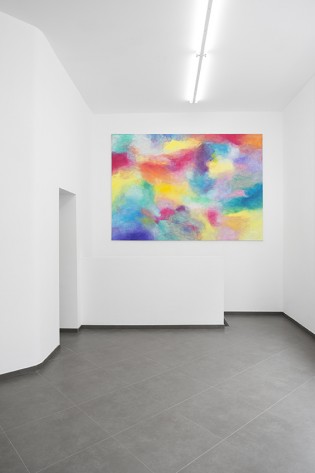
Untitled (Screensaver), 2013
Oil on canvas
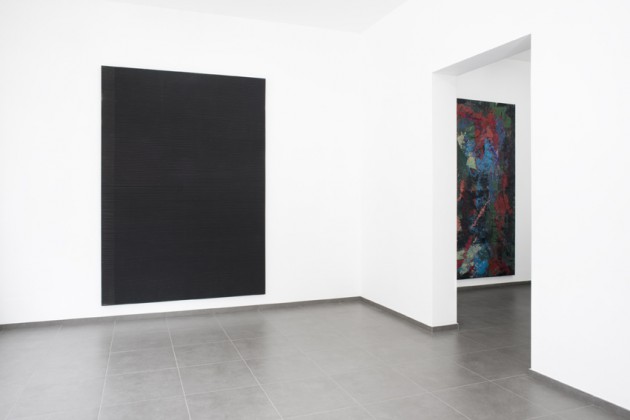
Lignes-report V, 1978
290 x 205 cm
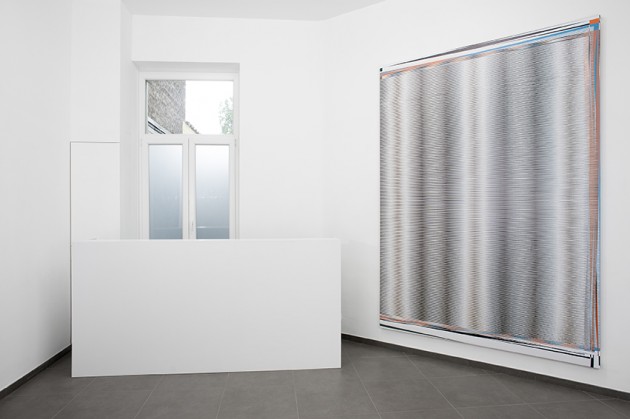
Scan 33, 2013
UV Print on Vinyl
290 x 205 cm
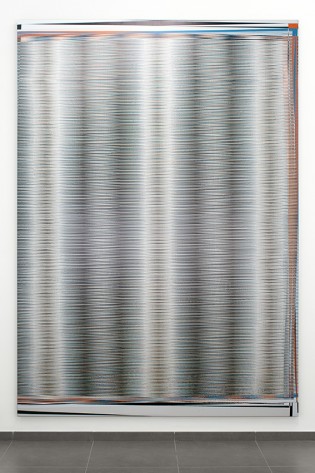
Scan 33, 2013
UV Print on Vinyl
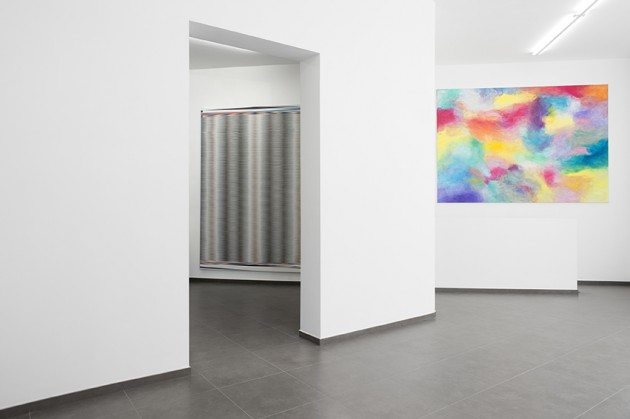
Right: Jean-Baptiste Bernadet
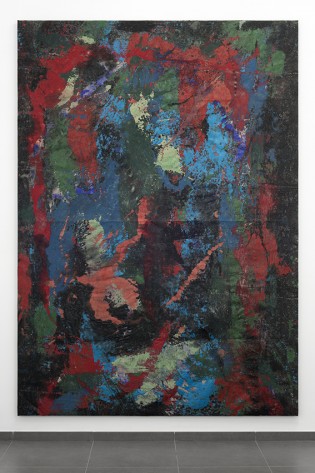
Reverse Quadchrome (RGB), 2013
oil-based enamel and linen
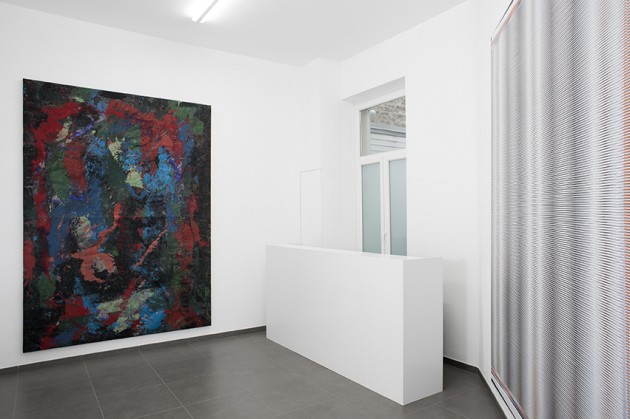
Right: Travess Smalley